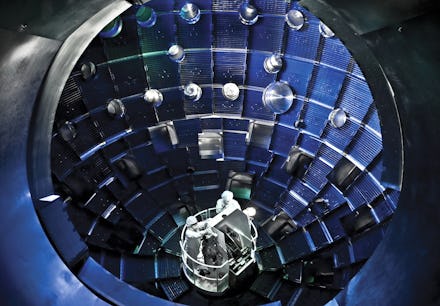Scientists Are One-Step Closer to Creating Nuclear Fusion. Here's What That Means in Plain English.

What’s the breakthrough? Scientists at the Lawrence Livermore National Laboratory in California have made significant progress in understanding how to create nuclear fusion reactions with lasers. In a paper published in the journal Nature this week, researchers described experiments that were able to produce more energy from the fusion reactions than the amount that had been invested in the fusion fuel. The work was conducted at the National Ignition Facility (NIF), which opened in 2009 and has struggled so far to make progress in achieving a self-sustaining fusion reaction, called nuclear ignition. The energy yields from the latest experiments are 10 times the amounts produced previously, though still someway off the amount required for the ultimate goal of ignition.
Remind me, how does fusion work?
Fusion is a process where smaller atoms, typically hydrogen isotopes, are squeezed together to produce larger atoms. As part of the reaction some mass is converted, releasing huge amounts of energy. It is the process that powers our Sun and other stars — natural fusion reactors that last billions of years.
Image: A nuclear fusion reaction
How do we reproduce a sustainable fusion reaction on Earth? This is of course, incredibly difficult. The key to successful achieving ignition — the point at which a nuclear reaction becomes self-sustaining — is to (a) produce the reaction under incredibly high pressure, and (b) prevent the energy initially produced from being lost too quickly (confinement time). Both these factors help to overcome the natural tendency for the electrically charged atoms to repel.
There are two main methods being investigated. Each of these concentrate on optimizing one of the two critical factors.
One approach, called magnetic confinement fusion, uses magnets to confine the fuel. This technique is steadier, producing a longer reaction time (up to several seconds) but under only average pressure. This magnetic approach is more highly developed, and is generally considered the more promising technique so far.
Image: NIF fuel capsule (Credit: AAAS)
The other approach is used by scientists at the NIF, and uses lasers to compress the fusion fuel into increasingly small perfect spheres. This produces an astonishingly large pressure, though for only for a vanishingly short time — less than one billionth of a second.
Image: The NIF consists of 192 lasers that focus on a gold target capsule containing the fuel that is the size of a pinhead (2 mm). The energy causes implosion of the capsule, kickstarting a fusion reaction inside (Credit: NIF)
Why is this latest result exciting?
Image: Layout of the NIF. Beamlines in blue, and target chamber on right surrounded by switchyard in red (Image: Wikipedia)
The NIF has struggled so far to produce any notable amount of fusion energy. While magnetic experiments are still more advanced, these results are a significant step forward for laser-driven methods. Although laser methods have been capable of producing fusion energy since the 70’s, this is the first time the technique has produced more energy than was put into the reaction.
What was the trick that made this possible? Cool fuel compresses to a desirable higher density. This time though, scientists tried something unorthodox — to heat the fuel first. Although this meant the fuel didn’t compress as much, it was squeezed down more evenly, resulting in more energy being produced in the end. Encouragingly the method demonstrates “self-heating” — an early sign of generating a self-sustaining reaction where energy produced is re-deposited in the fuel instead of escaping.
What’s the catch? The experiment produces more energy than what is put in if only measuring the laser beams that eventually hit the fuel capsule. But around 99% of the original energy (1.8 megajoules) in the facility’s lasers is lost in order to produce these finely focused beams. This process will need to be much more efficient to produce an overall net energy gain for practical use.
Image: Energy loss in laser powered fusion (Credit: Wikipedia)
Just how close are we to sustainable fusion? In short: still a long way. While a step forward, the new laser-pulsing technique is limited and unlikely to eventually lead to a sustainable nuclear reaction. In these experiments, the fuel was cooled early, sacrificing the high pressure that will be needed to reach the ignition point. NIF scientists will need to come up with a different method to make further progress.
With an overall efficiency of under 1%, the laser powered technique is still trailing far behind magnetic confinement methods, which achieved a 65% energy ratio in 1997. In 2013, a magnetic fusion reactor in China recorded the longest fusion confinement time of 30 seconds. The world’s largest fusion facility, the International Thermonuclear Experimental Reactor (ITER) in France, is projected to begin operation in 2020 with full fusion power tests in 2028. The scientific community is hoping that it will be the first reactor to break the engineering milestone of producing more energy than the whole plant consumes.
Undoubtedly, there’s still a long way to go before either method produces an amount of fusion energy that we could use to power our cities. However, results like these recent experiments reported by the NIF represent encouraging, if somewhat slow, progress. Frustrations with the pace of results, as well as budget cuts, are a constant challenge to achieving the lofty goal of successful nuclear fusion. But it is important that we continue to throw our support behind the research, because at the end of the long and winding road awaits the Universe’s ultimate source of energy.
Correction (3/4/2013): The headline of this article has been modified to reflect that scientists are now closer to creating nuclear fusion reaction, but have not been able to do so yet.